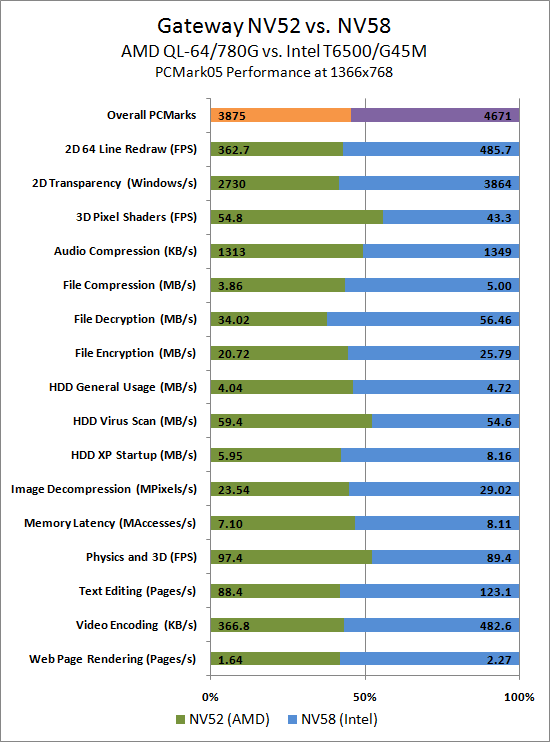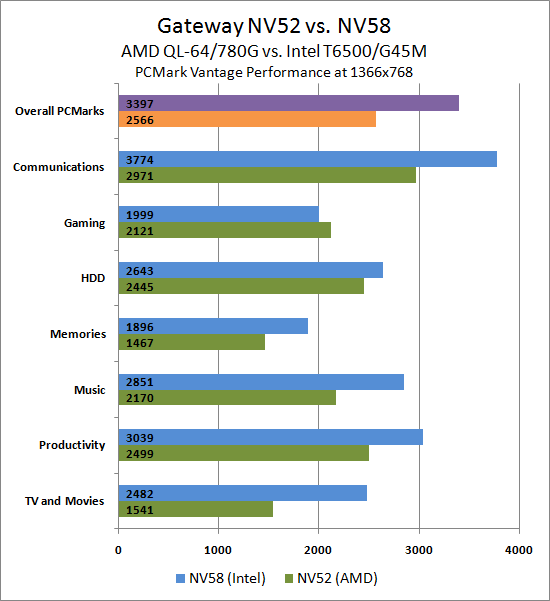Gateway AMD and Intel Laptops, a Platform Analysis
by Jarred Walton on August 12, 2009 2:00 AM EST- Posted in
- Laptops
PCMark Performance - AMD vs. Intel
Futuremark's method of determining composite scores in PCMark (and 3DMark) can be something of a mystery. Rather than taking the results at face value, we felt it would be more beneficial to show the individual scores for the various tests. We'll start with PCMark05, which is somewhat outdated relative to current software but also provides a more realistic look at how many people continue to use their computers (i.e. most people continue to use single-threaded applications more than multi-threaded applications).

In PCMark05, the Intel system ends up 20.5% faster in the overall metric, but individual scores range from Intel leading by 66% (File Encryption) to AMD leading by 26% (3D Pixel Shaders). A couple other important metrics are Web Page Rendering, HDD XP Startup, and HDD General Usage. These are all common situations that you encounter any time you use a computer, and Intel leads by 38%, 37%, and 17% in these tests, respectively. During testing, it was obvious that the Intel system was substantially faster in general use. Booting both systems, it would always finish loading Windows noticeably faster, and when we ran a disk defragment on both systems after installing all of the test software the AMD system took hours longer to finish.
It should be clear why the AMD system wins in the Physics and 3D (9%) and 3D Pixel Shaders (26%) tests. What's not so clear is why AMD would win in the HDD Virus Scan (8%) result, and the likely culprit is the Seagate hard drive is faster than the Hitachi HDD in the NV58 in this specific test. It's also important to remember that individual scores can fluctuate quite a bit between runs on PCMark05 - up to 12% between the various runs we conducted on these two laptops. The overall scores on the other hand remain relatively consistent. Let's move on to PCMark Vantage and see if the picture changes at all.

This time the Intel system is 32% faster in the composite score, with individual scores ranging from 6% in AMD's favor to 61% in Intel's favor. Again, AMD takes the Gaming crown, although as we shall see shortly the 6% margin of victory is highly suspect when we get to actual games. Outside of the HDD test - a test that logically focuses more on the hard drive than the rest of the system - Intel maintains a comfortable lead of 20% or more.
The short story to this point is that not only does the Intel system provide substantially better battery life, it also provides a much snappier user experience. If all you're looking for is a typical office computer, the extra $80 you spend for the NV58 is definitely a worthwhile investment compared to the NV52. There is still the question of graphics, of course, so let's look at the last area and consider how much gaming performance matters in your laptop purchasing decision.
Update
Here's an alternate chart for PCMark Vantage showing relative performance. Given the disparity in scores for PCMark05, we didn't bother creating this style of chart.











67 Comments
View All Comments
KidneyBean - Wednesday, August 12, 2009 - link
It's nice to see some humor in these articles. Nice to change it up. Reminds me of reading Mark Minasi tech books, and how much easier occasional humor makes it for me to read tech info.IntelUser2000 - Wednesday, August 12, 2009 - link
Jarred, the 475MHz core clock on the GMA 4500 is wrong. That has been the clock speed for pre-launch platforms. The GM45's GMA 4500MHD runs at 533MHz. Minor mistake but still a mistake.HexiumVII - Wednesday, August 12, 2009 - link
Can anyone comment on the performance of Aero with comparing the G45 with the X3200? I had a tablet with an X3500 that was a bit clunky with Win7 Aero Beta. It got a little better with RC drivers, but still not as snappy as 2D mode or dedicated graphics.JarredWalton - Wednesday, August 12, 2009 - link
I didn't notice any issues with normal applications in Windows Vista, but I don't know about Win7 yet. I will try to find time to do a follow-up looking at Win7 performance, and from what I've heard it's overall better than Vista (Gary for instance has it running on a netbook and he's very happy, whereas he hated Vista on the same netbook). Intel's Win7 drivers are likely still a work in progress as well, but at least you can get regular IGP driver updates from Intel.JarredWalton - Wednesday, August 12, 2009 - link
All I know is that GPU-Z reported the GMA 4500MHD as 475MHz. I would guess that either the utility is wrong (possible), or Intel gives vendors some leeway in the GPU/chipset clocks (also possible). If you have another utility that will be more reliable for determining the Intel IGP clock, let me know.IntelUser2000 - Wednesday, August 12, 2009 - link
Just take a look at the datasheet, its that simple: http://www.intel.com/Assets/PDF/datasheet/320122.p...">http://www.intel.com/Assets/PDF/datasheet/320122.p...The GPU-Z utility is bad. It's nowhere near the CPU counterpart. That aside, Intel doesn't really give out reading the GPU clock easily, and the 475MHz was also what was used in the pre-launch(ie. beta) GM45 platforms.
I heard Everest is more accurate, but in terms of actually measuring, there probably isn't one that measures the Intel IGPs properly.
IntelUser2000 - Wednesday, August 12, 2009 - link
http://www.beareyes.com.cn/2/lib/200810/13/335/gpu...">http://www.beareyes.com.cn/2/lib/200810/13/335/gpu...Please see how G45(desktop version) shows on the GPU-Z. It should show similar thing to above, unless the newer version updated to change that its 800MHz.
In reality, it isn't really measuring the clock.